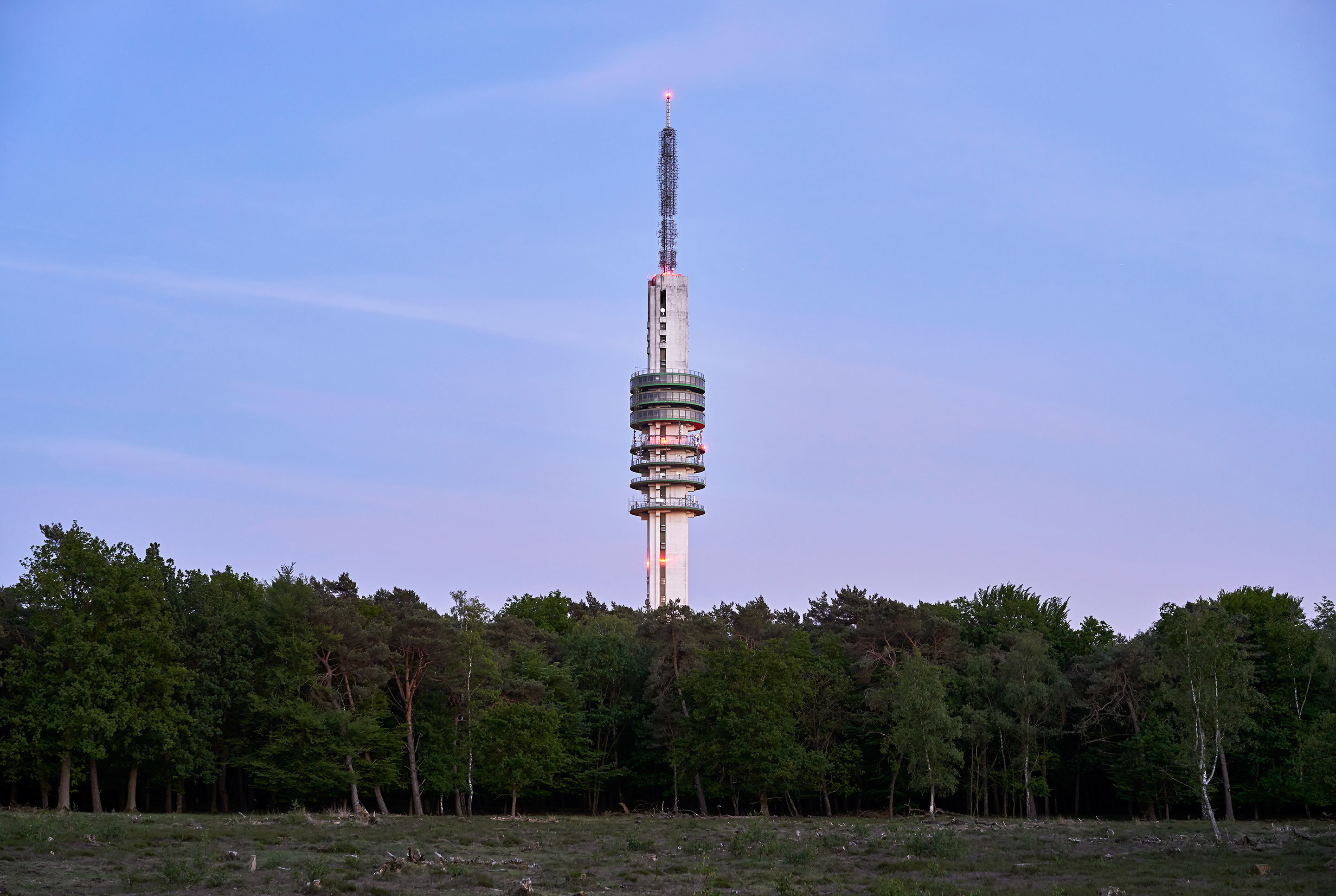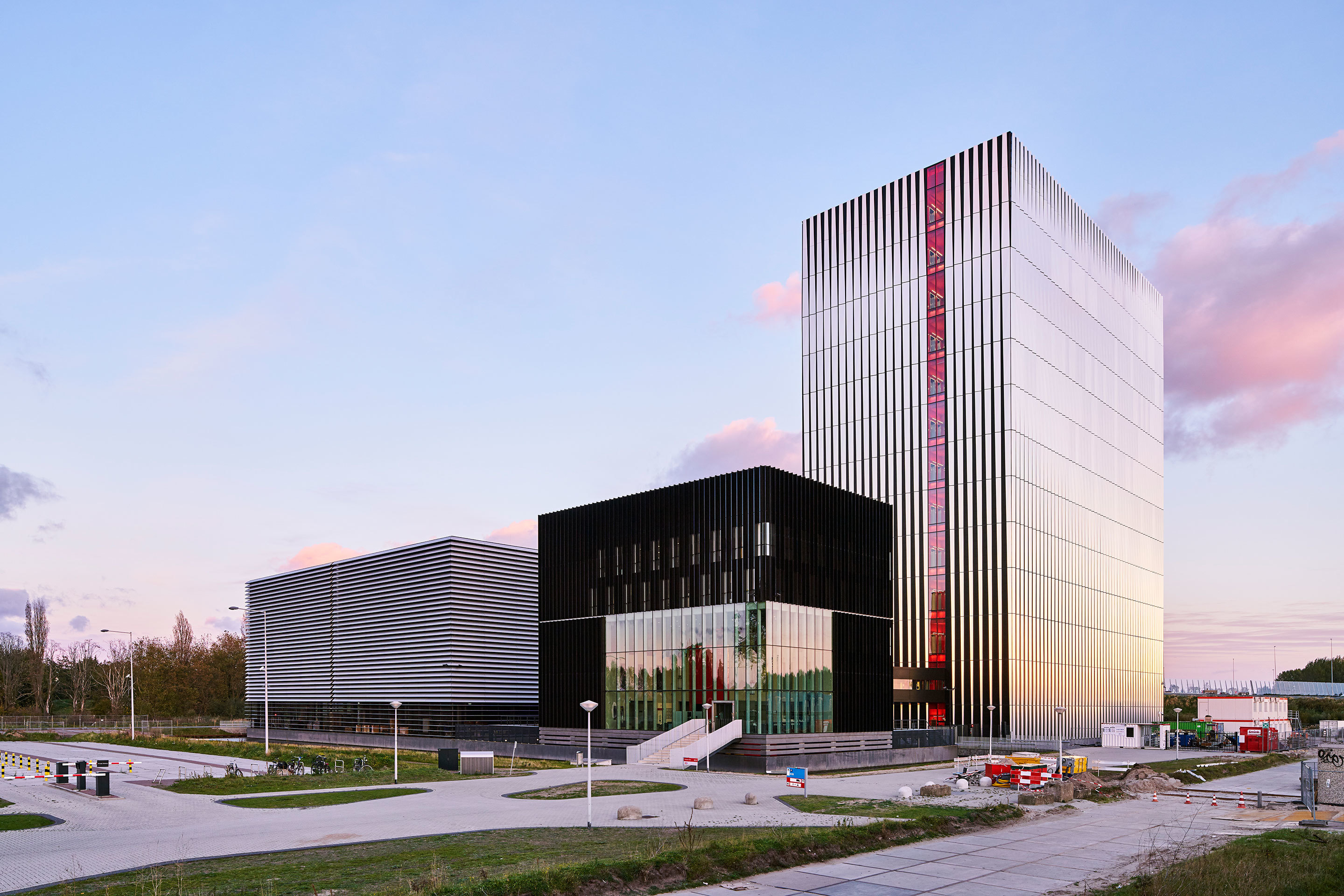Title: Acid Clouds
Content type: Photography Series and Essay
Credits: Niels Schrader (co-head, BA Graphic Design and MA Non Linear Narrative, KABK and a participant in the Design Research Club of the Design and the Deep Future Lectorate 2018-2019) in collaboration with Roel Backaert
Year: Ongoing project
‘WHAT IS THE PHYSICAL IMPACT OF THE VIRTUAL DATA PARADIGM ON OUR LIVING ENVIRONMENT AND WHEN, WHERE AND HOW DOES IT MANIFEST?’
Introduction:
Niels Schrader is an information designer. Alongside his design studio Mind Design, he is the co-head of the KABK Graphic Design department and the Non Linear Narrative master programme and regularly writes for design publications.
His photographic research project Acid Clouds traces the physical impacts of virtual data in the Netherlands. Through night-time photography, Schrader and Backaert documented the increasing amount of heavily secured data centres in the Netherlands. The project grows out of Schrader’s philosophy of communication and design—which relies on interactive processes and participation through questioning. He describes the project as ‘an attempt to portray the environmental and psychological impacts of our ever-accumulating software and data waste through photographic portraits of datacentres’.
The following text, Acid Clouds by Schrader, was first published on Open! in September 2019. It outlines the context in which his research project sits and is interspersed here with photographs from the project.
Acid Clouds

To date, critiques of technology have been focused on the environmental harm caused by sourcing the raw materials for, and the manufacturing, shipping and disposing of, our hardware. There is an urgent need, however, to scrutinize the environmental and psychological impacts of our ever-accumulating software and data waste. Undertaken as part of the Koninklijke Academie van Beeldende Kunsten (KABK) Research Group 2018, Niels Schrader uses online tools and published online media in combination with site immersion and visual analysis to understand more fully what happens when the resources needed to create, share and store our daily output of 2,5 quintillion bytes of so-called virtual data encroach on the physical environment.

Storage as a Concept
The number of computer data storage facilities has grown exponentially in the last few years. This is no surprise given the global increase in consumption of digital content, propelled by seemingly unlimited bandwidth and ubiquitous WiFi coverage. However, little attention is being paid to the ecological effects of these endlessly humming, heat-producing and energy-draining architectural structures now often among the biggest CO₂ polluters of the environment.
Server farms are large-scale repositories of data that require a massive maintenance framework. The agricultural reference in the name is no coincidence. With the rise of capitalism, farmers began to produce for the purpose of profit accumulation instead of personal or local consumption, and crops became a commodity to be traded. In the supply chain, storage has always played a key role. It made speculation possible, allowing the sale of agricultural products in times of scarcity and their purchase during a market surplus. Simply put, it became possible to create an artificial shortage that leveraged the demand. Data centres are the new control rooms of the automated landscape, which are not only storing the growing virtual knowledge of the world but also facilitating its distribution and capital flow. Behind high, windowless walls, the seemingly ephemeral, clean image of data solidifies into a much heavier and hardly degradable, resource-intensive condition, with growing implications for us all.

Growth Narrative
In the technology sector, the capitalistic promise of infinite economic growth is locked tight to Gordon Moore’s observation that the number of transistors on a chip doubles every year while its costs are halved. It describes the rapid growth in computational power over decades. Similar dynamics emerge in the global demand for data storage, and it seems that both are interlinked. The faster you can process data, the bigger your appetite for it. Conversely, the more data becomes available, the more computational power is required for storage and processing. The industry creates incentives for users not only to produce content but also to share and back it up, meaning, in fact, to endlessly duplicate and never delete. The tech industry labels continuous storage as the solution to our storage problem, but it is, in fact, creating it instead. The more Kilo, Mega, Giga, Tera, Peta or Exa, the less necessity we feel to control our digital clutter. Clutter that manifests itself as overly full inboxes with unanswered e-mails, deserted social media accounts we never actually visit anymore, long-forgotten download files clogging disk space and abandoned Dropbox folders storing identical data on multiple devices.
‘Data is the pollution problem of the information age’, says Bruce Schneier, cryptographer, computer security specialist and fellow at the Berkman Klein Center for Internet & Society at Harvard Law School, Cambridge, Massachusetts.
Digitalization creates an ever-increasing amount of data that society will eventually need to learn to dispose of. So even though IT efficiency is improving and data centres are becoming greener and consuming less power, these energy savings are offset by growing electricity consumption.

Physical Data
The IT sector labels its products using metaphors that suggest their association with the natural world and the qualities of cleanliness and transparency, thus covering up or deflecting attention from the damaging effects of technology on our living environment. Probably the most familiar of these deceptions is the projected image of a fluffy, vaporous ‘cloud’ used to misrepresent the power-consuming and earthbound qualities of digital data storage. Similarly, tech companies use visual and verbal rhetoric to present their large-scale storage facilities as clean, sterile and environmentally friendly domains. Google, for example, publishes on the web over-styled press images of its data centres to shape public perception.
There is a similar dissonance between the image of how tech companies market their services and the reality of what happens to consumer data. The sharing economy, constant online access and subscription-based models are presented as virtues, having obvious benefits for users. But in reality, emphasis on such qualities distracts from the real activity of data harvesting and offloading both storage and ownership to software companies. Having data is key and keeping it is even more so. To ensure that, server farms are highly protected spaces with concrete demarcations and tangible security measures. The buildings rarely have windows and are commonly surrounded by electric fences, security cameras and water moats. On the inside, they are packed with the latest security gadgets like motion detectors, iris scans, facial recognition systems or personalised access codes. It seems the physical access to the data is as regulated, monitored and restricted as the virtual one.
Today’s digital landscape is characterised by vast stores of loose, unrefined data, heavily harvested by national intelligence services and large private corporations to track people’s movements and behaviour. The typical business approach taken by these corporations is to capitalise on the fact that storage is cheap and to keep on accumulating data even if they haven’t yet determined a specific use for it.

Information Ecology
The environmental impact of data centres occurs in three main ways: electronic waste, energy consumption and carbon emissions. It is surprising how tangible these effects are.
The term e-waste refers to physical hardware within the buildings and its recycling or disposal. According to The Global E-waste Monitor published by the United Nations University, the global amount of e-waste is expected to grow to 52.2 billion kilograms in 2021, with an annual growth rate of three to four per cent. Propelled by short, market-driven replacement cycles, the amount of obsolete equipment is steadily increasing.
Energy consumption, on the other hand, concerns the power that is required to run the digital framework of the facilities. That includes powering the actual computers, but also the cooling infrastructures. The Independent reported that in 2015 the world’s data centres consumed about 3 per cent of the global electricity supply. A costly problem, which in 2008 translated roughly to an annual cumulative of $4.5 billion for data centre-related energy bills in the United States alone.

The third environmental impact of the data centres is the CO₂ emissions. Clearly, they are not directly produced by the data centre itself but by its energy supplier. If a data centre runs on fossil fuels, the equivalent of a new small city is added to the power grid every time somebody opens one of these facilities. Data centres accounted in 2015 for 2 per cent of worldwide greenhouse gas emissions. This is about the same carbon footprint as the airline industry.
It becomes clear that even though data is virtual by nature, we will reach the point where digital concerns hit physical constraints. Continuing along this path will leave a giant ecological and economic footprint. Looking forward, the Cisco Global Cloud Index predicts data centre traffic to jump to 15.3 yottabytes in 2020, a figure with 24 zeroes. As a result, the US Energy Information Administration expects global energy consumption is to grow by about 53 per cent by 2035.
A concrete example of how tangible the impact of data centres on our living habitat has become is Amsterdam’s acute capacity problem with the local power infrastructure. The city’s ambition to become Europe’s biggest data centre hub and its reputation as a start-up hotspot are starting to take their toll. As for Amsterdam claiming to be the number one digital gateway to Europe, its regional power grid is just not growing fast enough to keep up with all the new technological developments. As a result, the reserve capacity is used to stabilise the electricity supply and to put other municipal operations under pressure. It remains to be seen how further growth of this industry will be brought under control.
Solutions for this challenge are highly unlikely to come from either the big businesses that directly profit from our excessive behaviour or from the states and governments that show just as keen interest in our personal data. Neither should we fall into the trap of believing that increasing the degree of automation and making energy sources greener will solve the problem. Yet, blaming the storage industry solely would mean deliberately ignoring the responsibility that we as consumers have. Even the most eco-friendly technologies and highest recycling rates cannot compete with the simplest but most effective strategy: the avoidance of digital waste. It is about time to replace the growth narrative, acknowledge the fact that we are, in fact, part of the problem and learn how to control and dispose of our digital clutter.